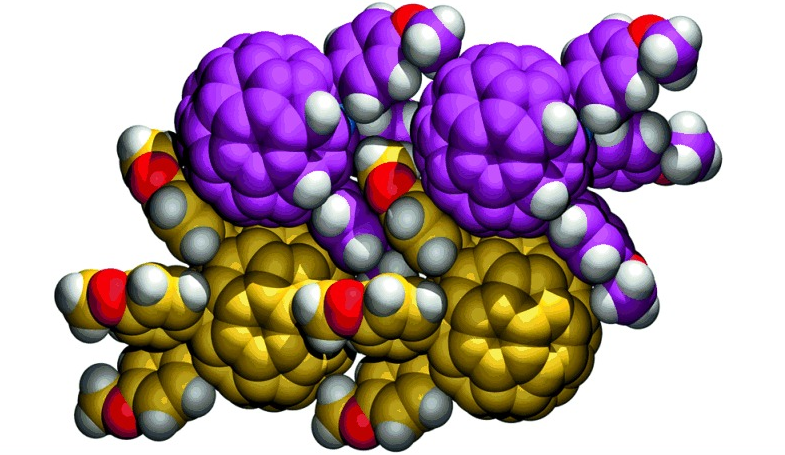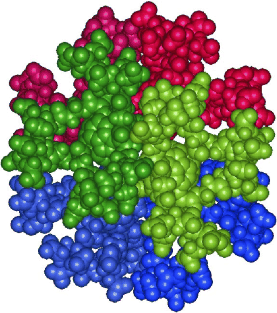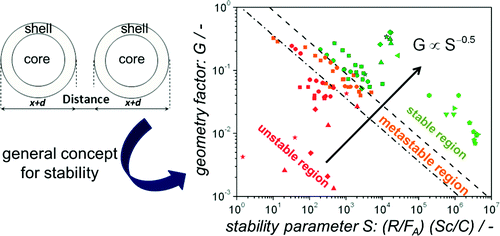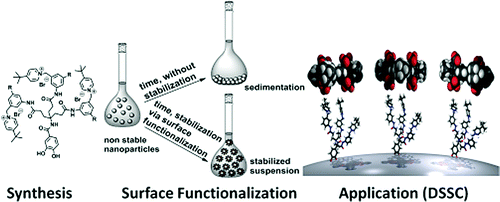Research
Synthetic Carbon Allotropes

Synthetic carbon allotropes (SCAs) such as fullerenes, carbon nanotubes and graphene are characterized by a number of outstanding and unprecedented properties such as electrical conductivity, mechanical stability and transparency. They are often regarded to be among the most promising candidates for future high performance materials. To reach this challenging goal, chemical functionalization of the parent systems will play a key role. Covalent and non-covalent transformations of SCA can considerably improve and tailor their solubility and processibility and combine their properties with those of other compound classes. For this purpose we are exploring the fundamental chemical properties of SCAs and determine, for example, reaction mechanisms, selectivities of transformations and characteristic addition patterns. Binding of a large variety of organic building blocks including dendrimers, porphyrines, rylenes, sugars and peptides has been accomplished. Using our knowledge in wet-chemical functionalization of fullerenes, carbon nanotubes and graphene; new molecular architectures with remarkable functions such as photo-induced electron transfer, superoxide dismutation and protein simulation have been created.
Selected Publications
- , , , , :
Invertomers of fullerenophosphates
In: Angewandte Chemie International Edition 52 (2013), p. 3521-3524
ISSN: 1433-7851
DOI: 10.1002/anie.201209981
C60-Trisaddukte: Fullerenophosphate mit einem C3-symmetrischen e,e,e-Trisadditionsmuster wurden regioselektiv synthetisiert. In– (siehe Bild; rot O, gelb P, blau C) und out-Invertomere bezüglich der Orientierung der P=O-Gruppe relativ zum Fullerenkern wurden isoliert und ihre Strukturen durch Röntgenstrukturanalyse bestätigt.
- , , , , :
New basic insight into reductive functionalization sequences of single walled carbon nanotubes (SWCNTs)
In: Journal of the American Chemical Society 135 (2013), p. 18385-18395
ISSN: 0002-7863
DOI: 10.1021/ja4063713
The reactivity of re duced single walled carbon nanotubes (SWCNTs) (carbon nanotubides), prepared under strict inert conditions in a glovebox with respect to the covalent functionalization with hexyl iodide and subsequent exposure to ambient conditions (air, moisture), was systematically investigated by Raman, absorption, fluorescence, and IR spectroscopy as well as by TG/MS measurements. We have discovered that the alkylation does not lead to a complete discharging of the tubes since follow-up reactions with moisture still take place leading to mixed functionalized carbon nanotube derivatives containing H- and OH-addends (but no carboxylates) next to the hexyl groups.
duced single walled carbon nanotubes (SWCNTs) (carbon nanotubides), prepared under strict inert conditions in a glovebox with respect to the covalent functionalization with hexyl iodide and subsequent exposure to ambient conditions (air, moisture), was systematically investigated by Raman, absorption, fluorescence, and IR spectroscopy as well as by TG/MS measurements. We have discovered that the alkylation does not lead to a complete discharging of the tubes since follow-up reactions with moisture still take place leading to mixed functionalized carbon nanotube derivatives containing H- and OH-addends (but no carboxylates) next to the hexyl groups.
- , , , , , , :
On the way to graphane - Pronounced fluorescence of polyhydrogenated graphene
In: Angewandte Chemie International Edition 52 (2013), p. 754-757
ISSN: 1433-7851
DOI: 10.1002/anie.201206799
Chemistry meets graphane: a Birch-type reaction using frozen water as a gentle proton source causes the exfoliation of graphite and formation of hydrogenated graphene with electronically decoupled π-nanodomains. This highly functionalized graphene displays pronounced fluorescence.
- , , , , :
Pentaarylazafullerenes and their triaryldihydro and tetraarylmonohydro precursors
In: Angewandte Chemie International Edition 51 (2012), p. 11722-11726
ISSN: 1433-7851
DOI: 10.1002/anie.201206878
Give me five! The title compounds were isolated from the acid-catalyzed reaction of a C59N precursor with electron-rich aromatic compounds. Single-crystal X-ray diffraction on two compounds reveals characteristic packing motifs; the triaryldihydro derivative has a pseudo-stacked arrangement (C violet/yellow, N blue, O red, H white).
- , , , , , , , , , , , :
Covalent bulk functionalization of graphene
In: Nature Chemistry 3 (2011), p. 279-286
ISSN: 1755-4330
DOI: 10.1038/nchem.1010
Graphene, a truly two-dimensional and fully π-conjugated honeycomb carbon network, is currently evolving into the most promising successor to silicon in micro- and nanoelectronic applications. However, its wider application is impeded by the difficulties in opening a bandgap in its gapless band-structure, as well as the lack of processability in the resultant intrinscially insoluble material. Covalent chemical modification of the π-electron system is capable of addressing both of these issues through the introduction of variable chemical decoration. Although there has been significant research activity in the field of functionalized graphene, most work to date has focused on the use of graphene oxide. In this Article, we report on the first wet chemical bulk functionalization route beginning with pristine graphite that does not require initial oxidative damage of the graphene basal planes. Through effective reductive activation, covalent functionalization of the charged graphene is achieved by organic diazonium salts. Functionalization was observed spectroscopically, and successfully prevents reaggregation while providing solubility in common organic media.
- :
The era of carbon allotropes
In: Nature Materials 9 (2010), p. 868-871
ISSN: 1476-1122
DOI: 10.1038/nmat2885
Twenty-five years on from the discovery of C60, the outstanding properties and potential applications of the synthetic carbon allotropes — fullerenes, nanotubes and graphene — overwhelmingly illustrate their unique scientific and technological importance.
Carbon is the element in the periodic table that provides the basis for life on Earth. It is also important for many technological applications, ranging from drugs to synthetic materials. This role is a consequence of carbon’s ability to bind to itself and to nearly all elements in almost limitless variety. The resulting structural diversity of organic compounds and molecules is accompanied by a broad range of chemical and physical properties. The tools of modern synthetic chemistry allow the tailored design of these properties by the controlled combination of structural and functional building blocks in new target systems.
- , , , , , , , , , :
Manipulating single-wall carbon nanotubes by chemical doping and charge transfer with perylene dyes
In: Nature Chemistry 1 (2009), p. 243-249
ISSN: 1755-4330
DOI: 10.1038/nchem.214
Single-wall carbon nanotubes (SWNTs) are emerging as materials with much potential in several disciplines, in particular in electronics and photovoltaics. The combination of SWNTs with electron donors or acceptors generates active materials, which can produce electrical energy when irradiated. However, SWNTs are very elusive species when characterization of their metastable states is required. This problem mainly arises because of the polydispersive nature of SWNT samples and the inevitable presence of SWNTs in bundles of different sizes. Here, we report the complete and thorough characterization of an SWNT radical ion-pair state induced by complexation with a perylene dye, which combines excellent electron-accepting and -conducting features with a five-fused ring π-system. At the same time, the perylene dye enables the dispersion of SWNTs by means of π–π interactions, which gives individual SWNTs in solution. This work clears a path towards electronic and optoelectronic devices in which regulated electrical transport properties are important.
- , , , , , :
High catalytic activity of dendritic C60 monoadducts in metal-free superoxide dismutation
In: Angewandte Chemie International Edition 47 (2008), p. 3991-3994
ISSN: 1433-7851
DOI: 10.1002/anie.200800008
Fullerene antioxidants: A direct correlation between the redox and structural properties of water-soluble fullerenes (see picture) and their reactivity towards superoxide is demonstrated. Some of the C60 monoadducts examined act as superoxide dismutase mimetics. The findings establish a guide for designing fullerene derivatives to catalytically decompose the superoxide radical anion.
Polycyclic Aromatic Hydrocarbons
Polycyclic aromatic hydrocarbons such as hexabenzocoronenes and rylenes (naphtylenes, perylenes) do not only represent partial structures of – and model compounds for – graphene; they also represent attractive building blocks for new molecular architectures. We are particularly interested in using them as chromophores, as redox-active components and as structure determining tectons for functional hybrid molecules. Other compound classes that we are extensively investigating with respect to new derivatization concepts are porpyhrine based molecules and calixarenes. Among our accomplishments in the chemistry of all these conjugated π-systems are the first examples of water-soluble perylenes and their use for non-covalent graphene functionalization, dendritic metalloporphyines as heme-proteine models and amphiphilic calixarenes as building blocks for the first shape persistent micelles.
Selected Publications
- , , , , :
HBC-porphyrin-close contact chromophores
In: Chemical Communications 49 (2013), p. 4827-4829
ISSN: 1359-7345
DOI: 10.1039/c3cc41740a
A photo/redoxactive hexa-peri-hexabenzocoronene-porphyrin conjugate with a direct connection between the two chromophores was synthesised using a formylated hexaphenylbenzene precursor.
The new synthetic carbon allotrope graphene has recently attracted much attention due to its unprecedented physical properties. Since graphene is a zero band-gap semiconductor, proper functionalization and/or modification of its structure is mandatory to open a band-gap, which represents an important prerequisite for many possible applications in the field of molecular electronics. In this regard, covalent attachment of photoactive molecules is a challenging subject. Next to the introduction of a band-gap such a chemical modification would also be associated with the development of interesting photo/redox activity profiles.
Wet chemical functionalization of graphene
In: Accounts of Chemical Research 46 (2013), p. 87-96
ISSN: 0001-4842
DOI: 10.1021/ar300116q
On the basis of our experience with fullerenes and carbon nanotubes, we have described a series of covalent and noncovalent approaches to generate graphene derivatives. Using water-soluble perylene surfactants, we could efficiently exfoliate graphite in water and prepare substantial amounts of single-layer-graphene (SLG) and few-layer-graphene (FLG). At the same time, this approach leads to noncovalent graphene derivatives because it establishes efficient π–π-stacking interactions between graphene and the aromatic perylene chromophors supported by hydrophobic interactions.
Tetrathiafulvalene-based nanotweezers-noncovalent binding of carbon nanotubes in aqueous media with charge transfer implications
In: Journal of the American Chemical Society 134 (2012), p. 9183-9192
ISSN: 0002-7863
DOI: 10.1021/ja211362z
As a suitable electron donor, π-extended tetrathiafulvalene (exTTF) stands out owing to its recognition of SWCNT through π–π stacking and electron donor–acceptor interactions. Herein, we explore the shape and electronic complementarity between different types of carbon nanotubes (CNT) and a tweezers-shaped molecule endowed with two exTTFs in water. The efficient electronic communication between semiconducting SWCNT/multiwall carbon nanotubes (MWCNT), on one hand, and the water-soluble exTTF nanotweezers 8, on the other hand, has been demonstrated in the ground and excited state by using steady-state as well as time-resolved spectroscopies, which were further complemented by microscopy.
- , , :
The potential of perylene bisimide derivatives for the solubilization of carbon nanotubes and graphene
In: Advanced Materials 23 (2011), p. 2588-2601
ISSN: 0935-9648
DOI: 10.1002/adma.201100300
- , , , , , , , :
Non-covalent chemistry of graphene: Electronic communication with dendronized perylene bisimides
In: Advanced Materials 22 (2010), p. 5483-5487
ISSN: 0935-9648
DOI: 10.1002/adma.201003206
Mutual attraction: π–π bonding promotes electronic interactions between graphene and a π-conjugated perylene in a liquid dispersion. Herein, we report for the first time on the electronic communication between graphene with the perylene bisimide (PBI) when both are deposited on a surface or dispersed in homogeneous solution. This interaction is provided by the non-covalent binding of their conjugated π-systems.
- , , :
Synthesis and aggregation properties of water-soluble newkome-dendronized perylenetetracarboxdiimides
In: European Journal of Organic Chemistry (2007), p. 5497-5505
ISSN: 1434-193X
DOI: 10.1002/ejoc.200700567
The synthesis and characterization of three highly water-soluble perylenetetracarboxdiimide (“perylene bisimide”, PBI) dyes 1 and 2b is presented. The water solubility is provided by peripheral dendronization with 1G- and 2G-Newkome dendrons. The aggregation behaviour of these amphiphiles in water and that of their tert-butyl-protected precursor molecules 3 and 4 in organic solvents was investigated by UV/Vis- and fluorescence spectroscopy. The symmetric 1G-dendronized dye 1a forms aggregates more easily than its 2G-counterpart 1b. The asymmetric derivatives 2b reveals pronounced aggregation properties due to the presence of both a 2G-dendron and a flexible and non-bulky dodecyl substituent. The 1G-analogue 2a is insoluble in water as a result of insufficient overall hydrophilicity caused by only one 1G-Newkome dendron. Within the series of water-soluble perylenes 1 and 2b the asymmetric derivative 2b forms the most regularly shaped micelles in water (pH = 7.2) with a mean diameter of 16 nm as demonstrated by transition electron microscopy (TEM). The bola-amphiphiles 1a and 1b form a distribution of smaller aggregates on average with less defined shape. (© Wiley-VCH Verlag GmbH & Co. KGaA, 69451 Weinheim, Germany, 2007)
Supramolecular Chemistry
For the construction of molecular assemblies and materials of higher hierarchical order, we systematically employed non-covalent binding motifs such as hydrogen bonding, electrostatic bonding and hydrophobic interactions. For this purpose we design and synthesize new molecules, which carry the required recognition motifs in their periphery. Examples are precisely defined oligo-electrolytes with up 60 charges in their periphery or porpyrines, perylenes, fullerenes and carbon nanotubes that involve Hamilton receptor/cyanuric acid binding motifs. Of practical use are in particular layer-by-layer assembly architectures where positively and negatively charged chromophores are successively deposited on surfaces. In this way for example new photovoltaic devices can be designed.
Selected Publications
- , , , , , , , , , , , :
Improving the Charge Transport in Self-Assembled Monolayer Field-Effect Transistors: From Theory to Devices
In: Journal of the American Chemical Society 135 (2013), p. 4893-4900
ISSN: 0002-7863
DOI: 10.1021/ja401320n
A three-pronged approach has been used to design rational improvements in self-assembled monolayer field-effect transistors: classical molecular dynamics (MD) simulations to investigate atomistic structure, large-scale quantum mechanical (QM) calculations for electronic properties, and device fabrication and characterization as the ultimate goal. The MD simulations reveal the effect of using two-component monolayers to achieve intact dielectric insulating layers and a well-defined semiconductor channel. The QM calculations identify improved conduction paths in the monolayers that consist of an optimum mixing ratio of the components. These results have been used both to confirm the predictions of the calculations and to optimize real devices. Monolayers were characterized with X-ray reflectivity measurements and by electronic characterization of complete devices.
- , , , :
Pairing fullerenes and porphyrins: Supramolecular wires that exhibit charge transfer activity
In: Journal of the American Chemical Society 132 (2010), p. 10786-10795
ISSN: 0002-7863
DOI: 10.1021/ja101937w
A concept is elaborated of pairing electron donors and electron acceptors that share a common trait, wire-like features, as a powerful means to realize a new and versatile class of electron donor−acceptor nanohybrids. Important variables are fine-tuning (i) the complexation strength, (ii) the electron/energy transfer behavior, and (iii) the solubilities of the resulting architectures. In particular, a series of supramolecular porphyrin/fullerene hybrids assembled by the hydrogen bonding of Hamilton receptor/cyanuric acid motif has been realized. Putting the aforementioned variables into action, the association constants (Kass), as they were determined from 1H NMR and steady-state fluorescence assays, were successfully tweaked with values in the range of 104−105 M−1.
- , , , , , :
Cooperativity and tunable excited state deactivation: Modular self-assembly of depsipeptide dendrons on a Hamilton receptor modified porphyrin platform
In: Journal of the American Chemical Society 130 (2008), p. 8491-8501
ISSN: 0002-7863
DOI: 10.1021/ja8018065
A series of novel supramolecular architectures were built around a tin tetraphenyl porphyrin platform 6—functionalized by a 2-fold 1-ethyl-3-3-(3-dimethylaminopropyl)carbodiimide (EDC) promoted condensation reaction—and chiral depsipeptide dendrons of different generations 1—4. Here, implementation of a Hamilton receptor provided the necessary means to keep the constituents together via strong hydrogen bonding. Characterization of all architectures has been performed, including 4 which is the fourth generation, on the basis of NMR and photophysical methods. In particular, several titration experiments were conducted suggesting positive cooperativity, an assessment that is based on association constants that tend to be higher for the second binding step than for the first step. Importantly, molecular modeling calculations reveal a significant deaggregation of the intermolecular network of 6 during the course of the first binding step. As a consequence, an improved accessibility of the second Hamilton receptor unit in 6 emerges and, in turn, facilitates the higher association constants. The features of the equilibrium, that is, the dynamic exchange of depsipeptide dendrons 1−4 with fullerene 5, was tested in photophysical reference experiments. These steady-state and time-resolved measurements showed the tunable excited-state deactivations of these complexes upon photoexcitation.
- , , , , , , :
Implementation of a Hamiliton-receptor-based hydrogen-bonding motif toward a new electron donor-acceptor prototype: Electron versus energy transfer
In: Journal of the American Chemical Society 129 (2007), p. 16057-16071
ISSN: 0002-7863
DOI: 10.1021/ja075751g
A new modular concept for the self-assembly of electron donor−acceptor complexes is presented that ensures (i) fine-tuning the strength of the complexation, (ii) controlling the electronic coupling to impact electron and energy transfer processes, and (iii) high solubility of the corresponding hybrid architectures. This task has been realized through developing a series of porphyrin−fullerene donor−acceptor systems held together by a Hamilton-receptor-based hydrogen-bonding motif. In this context, novel libraries of C60 monoadducts (1) containing cyanuric acid side chains and of tetraphenylporphyrin derivatives (2) involving the complementary Hamilton-receptor unit were synthesized.
- , , , , :
Supramolecular structure of 5-nm spherical micelles with D3 symmetry assembled from amphiphilic [3:3]-hexakis adducts of C60
In: Angewandte Chemie International Edition 46 (2007), p. 4393-4396
ISSN: 1433-7851
DOI: 10.1002/anie.200604784
Six molecules of an amphiphilic fullerene derivative make up the smallest persistent micelle detected so far (see picture, the six amphiphilic molecules are shown in different colors). These micelles can be used to systematically study the factors that determine the structural persistence of micelles and may lead to the design of tailor-made supramolecular containers.
- , , , , :
Switchable supramolecular organization of structurally defined micelles based on an amphiphilic fullerene
In: Angewandte Chemie International Edition 44 (2005), p. 2976-2979
ISSN: 1433-7851
DOI: 10.1002/anie.200462465
Functionalization Of Nanoparticles
We are investigating the controlled chemical functionalization of inorganic nanoparticles (NP) such as ZnO-, TiO2-, Ag- and Au quantum dots and ZnO nanorods with organic building blocks. The latter include neutral and charged dendrimers, porphyrines and H-bonding architectures such as cyanuric acid derivatives and Hamiliton receptors. In this way we are able to improve the stability and dispersibility of the nanoparticles and control their supramolecular aggregation including layer-by-layer assembly on surfaces. The chemical derivatization of the nanoparticles with redox-active molecules and light-harvesting antennas is also important for their mplemention into optoelectronic applications.
Selected Publications
- , , , , , , :
Experimental and Theoretical Studies of the Colloidal Stability of Nanoparticles−A General Interpretation Based on Stability Maps
In: Acs Nano 5 (2011), p. 4658-4669
ISSN: 1936-0851
DOI: 10.1021/nn200465b
The current work addresses the understanding of the stabilization of nanoparticles in suspension. Specifically, we study ZnO in ethanol for which the influence of particle size and reactant ratio as well as surface coverage on colloidal stability in dependence of the purification progress was investigated. The results revealed that the well-known ζ-potential determines not only the colloidal stability but also the surface coverage of acetate groups bound to the particle surface. The acetate groups act as molecular spacers between the nanoparticles and prevent agglomeration. Next to DLVO calculations based on the theory of Derjaguin, Landau, Verwey and Overbeek using a core–shell model we find that the stability is better understood in terms of dimensionless numbers which represent attractive forces as well as electrostatic repulsion, steric effects, transport properties, and particle concentration. containers.
- , , , , , , , :
Efficient synthetic access to cationic dendrons and their application for ZnO nanoparticles surface functionalization: New building blocks for dye-sensitized solar cells
In: Journal of the American Chemical Society 132 (2010), p. 17910-17920
ISSN: 0002-7863
DOI: 10.1021/ja106076h
A new concept for the efficient synthesis of cationic dendrons, 4-tert-butyl-1-(3-(3,4-dihydroxybenzamido)benzyl)pyridinium bromide (17), 1,1′-(5-(3,4-dihydroxybenzamido)-1,3-phenylene)bis(methylene)bis(4-tert-butylpyridinium) bromide (18), N1,N7-bis(3-(4-tert-butyl-pyridium-methyl)phenyl)-4-(3-(3-(4-tert-butyl-pyridinium-methyl)phenyl-amino)-3-oxopropyl)-4-(3,4-dihydroxybenzamido)heptanediamide tribromide (19), and N1,N7-bis(3,5-bis(4-tert-butyl-pyridium-methyl)phenyl)-4-(3-(3,5-bis(4-tert-butyl-pyridinium-methyl)phenylamino)-3-oxopropyl)-4-(3,4-dihydroxybenzamido)heptanediamide hexabromide (20), and their facile binding to zinc oxide (ZnO) nanostructures is introduced.
- , , , , , , :
Grafting porphyrins (face-to-edge/orthogonal versus face-to-face/parallel) to ZnO en route toward dye-sensitized solar cells
In: Journal of Physical Chemistry B 114 (2010), p. 14671-14678
ISSN: 1520-6106
DOI: 10.1021/jp102737a
Novel types of binding motives have been investigated within the context of sensitizing ZnO-based dye-sensitized solar cells with metalloporphyrins. In particular, a complementary class of metalloporphyrin has been synthesized to probe the impact of a face-to-edge/orthogonal versus face-to-face/parallel orientation of the metalloporphyrin with respect to ZnO and has been compared to TiO2-based dye-sensitized solar cells. Our studies provide a deep and detailed understanding of the individual electron-transfer processes at the ZnO/metalloporphyrin interface, that is, electron injection, recombination, and dye regeneration, by means of steady-state and time-resolved techniques. Interestingly, we found that for our novel ZnO/metalloporphyrin systems, the injection efficiencies are close to unity, despite their long, nonconjugated anchoring group length.
- , , , , :
ToF-SIMS and XPS studies of the adsorption characteristics of a Zn-porphyrin on TiO2
In: Langmuir 26 (2010), p. 3531-3538
ISSN: 0743-7463
DOI: 10.1021/la9032139
Time-of-flight secondary ion mass spectrometry (ToF-SIMS) and X-ray photoelectron spectroscopy (XPS) were used to study monolayers (ML) and thick films of porphyrin Zn-TESP (C67H75N5O5SiZn) attached to titanium dioxide (TiO2) substrates via silanization. Films on ideal hydroxyl-terminated silicon (SiO2) surfaces were used for comparison. ToF-SIMS and XPS spectra show that the type of adsorption varies depending on the thickness of the organic film, the preparation temperature, and the adsorption time. We show that the intensity of a molecular peak at mass 1121.5 u in ToF-SIMS can be used as a direct measure of the ratio of chemisorption/physisorption of Zn-TESP. On TiO2, the amount of chemisorbed porphyrin can be increased by increasing the reaction temperature and time during the silanization process.
Communication via electron and energy transfer between zinc oxide nanoparticles and organic adsorbates
In: Journal of Physical Chemistry C 113 (2009), p. 4669-4678
ISSN: 1932-7447
DOI: 10.1021/jp810696h
Stable ZnO nanoparticles suitable for further surface functionalization were synthesized in the liquid phase from homogeneous ethanolic solutions of the precursors lithium hydroxide and zinc acetate. It was found that the growth of the particles was governed by temperature as well as the presence of the reaction byproduct lithium acetate during the aging process. In particular, the reaction could be almost completely arrested by removal of this byproduct. The “washing” consisted of repeated precipitation of the ZnO particles by addition of alkanes such as heptane, removal of the supernatant, and redispersion in ethanol. Furthermore, the surface of the colloidal ZnO nanoparticles was successfully modified by catechol-anchoring group containing dye molecules for the study of photochemical properties.























